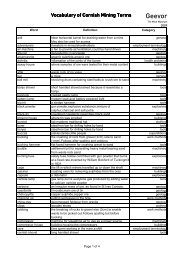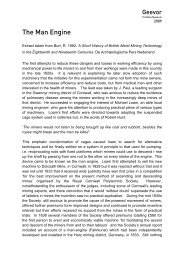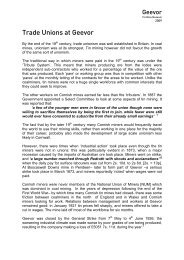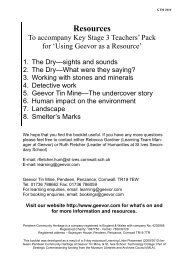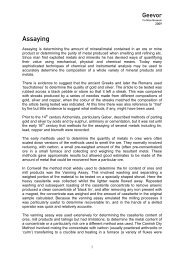Ore Extraction and Rock Breaking Techniques R ... - Geevor Tin Mine
Ore Extraction and Rock Breaking Techniques R ... - Geevor Tin Mine
Ore Extraction and Rock Breaking Techniques R ... - Geevor Tin Mine
You also want an ePaper? Increase the reach of your titles
YUMPU automatically turns print PDFs into web optimized ePapers that Google loves.
<strong>Geevor</strong><br />
<strong>Tin</strong> <strong>Mine</strong> Museum<br />
2009<br />
Early Methods: The <strong>Extraction</strong> of <strong>Ore</strong> <strong>and</strong><br />
<strong>Rock</strong> <strong>Breaking</strong> <strong>Techniques</strong><br />
Extract taken from Burt, R. 1982. A Short History of British Metal Mining Technology<br />
in the Eighteenth <strong>and</strong> Nineteenth Centuries. De Archæologische Pers Nederl<strong>and</strong><br />
<strong>Extraction</strong> systems<br />
Once the lodes had been reached, the methods of ore extraction were similar for<br />
both shaft <strong>and</strong> adit mines. Two systems were used; one for rake or hading veins<br />
(narrow but continuous lodes) <strong>and</strong> the other for pipe <strong>and</strong> f lat works (large but<br />
irregular masses of ore). A . H . Stokes described rake veins as ore-filled fissures<br />
<strong>and</strong> crevices that are generally vertical, or highly inclined, <strong>and</strong> run through a series<br />
of rocks, or beds of limestone; pipe veins were irregular ore-filled cavities or<br />
hollow spaces parallel to the bedding of the rocks in which they occur, often nearly<br />
horizontal; flat works were very similar to pipe veins, <strong>and</strong> may be termed an<br />
irregular horizontal cavity filled with minerals where the roof <strong>and</strong> floor are only a<br />
few feet apart, but whereas the pipe vein is accompanied with many branches <strong>and</strong><br />
leaders, one from another, the flat work has none, <strong>and</strong> is often a lonely chamber<br />
without leaders or stem. Since both types of deposit might be encountered in the<br />
same mine, both extraction techniques were often in use together.<br />
<strong>Rock</strong>-breaking techniques<br />
Unlike coal miners, metal miners were rarely able to cut their way with picks alone<br />
<strong>and</strong> from an early date artificial techniques were used for softening <strong>and</strong> breaking<br />
rock. These techniques improved considerably during the eighteenth <strong>and</strong> nineteenth<br />
centuries <strong>and</strong> greatly increased the speed <strong>and</strong> efficiency of driving shafts <strong>and</strong> adits<br />
as well as the extraction of ore.<br />
Early methods<br />
At the beginning of the eighteenth century many mines still relied on the ancient<br />
practices of firing or fire-setting; plug <strong>and</strong> feathering; or perhaps splitting with
<strong>Geevor</strong><br />
<strong>Tin</strong> <strong>Mine</strong> Museum<br />
2009<br />
quick lime. The use of fire to soften rock was described as early as the second<br />
century B.C. by Agatharchides <strong>and</strong> was still in use in parts of Germany down to the end<br />
of the nineteenth century. The technique involved building a small f i re against the<br />
ore face, the heat softening <strong>and</strong> cracking the rock. It was well suited to mines where<br />
the ore was carried in quartzy gangue rock, as in parts of Cumberl<strong>and</strong>, but was little<br />
used where the ore was a soft sulphide of lead <strong>and</strong> the gangue was principally<br />
calcite, as in Swaledale. Firing was slow <strong>and</strong> relatively inefficient but its main<br />
drawbacks were the dangers which it created for the miners, through fire,<br />
explosion, or suffocation, <strong>and</strong> the time needed to clear badly ventilated workings<br />
of smoke. These difficulties meant that firing could only be used under<br />
carefully controlled conditions in relatively shallow workings. In Derbyshire the<br />
mineral customs of the High <strong>and</strong> Low Peaks contained regulations to control the<br />
general practice of firing <strong>and</strong> to prevent operations in ore mines from<br />
unduly affecting neighbouring <strong>and</strong> sometimes interconnecting workings. Article<br />
40, for example, of the code drawn up in 1665 for the Peak read:<br />
'We say that any miner in an open rake may kindle or light his fire four of the clock<br />
in the afternoon, giving his neighbours lawful warning thereof’.<br />
The only alternative to firin g before the late seventeenth century were the<br />
equally ancient practices of plug <strong>and</strong> feathering or the similar technique of liming.<br />
The latter technique was probably uncommon in metal mines though 'blast holes'<br />
charged with lime were discovered in 'old mines' in the Vale of Towy,<br />
Caernarvonshire. For plug <strong>and</strong> feathering -sometimes known as 'wedging'- the<br />
miner drilled a series of holes, inserted wedges with circular backs into each hole,<br />
<strong>and</strong> then drove plugs between them. By hammering along the line of plugs the rock<br />
was gradually split. Although safer than firing, presenting no ventilation problems<br />
<strong>and</strong> more efficient for some purposes, plug <strong>and</strong> feathering had the disadvantages<br />
of requiring more labour <strong>and</strong> producing broken rock <strong>and</strong> ore which was generally<br />
too large for easy dressing. The technique possibly survived in some metal mines<br />
into the late nineteenth century but was more commonly used in slate mines,<br />
collieries <strong>and</strong> quarries where the shattering effect of gunpowder blasting <strong>and</strong> later<br />
dynamite was often undesirable.






